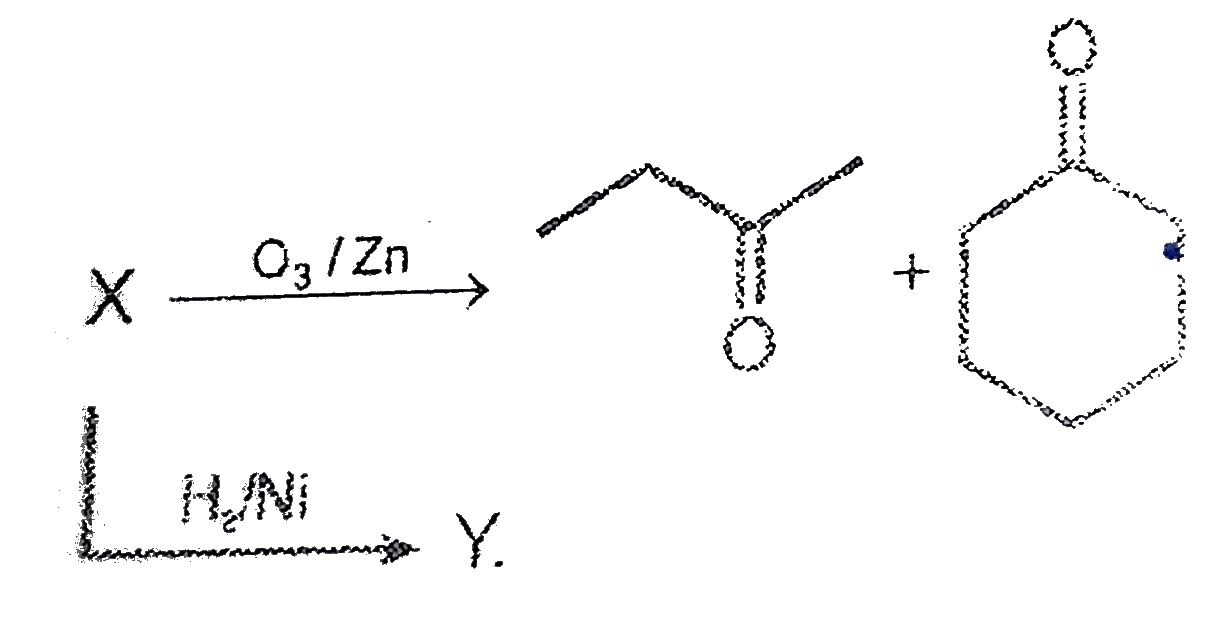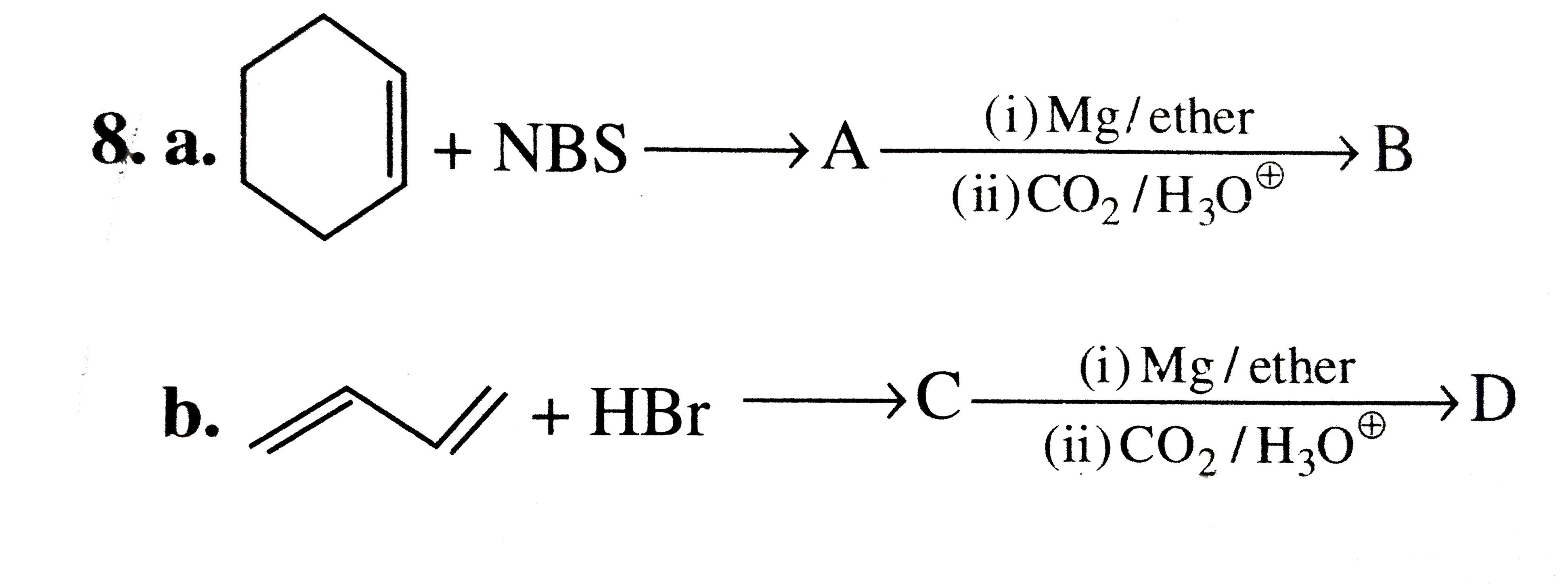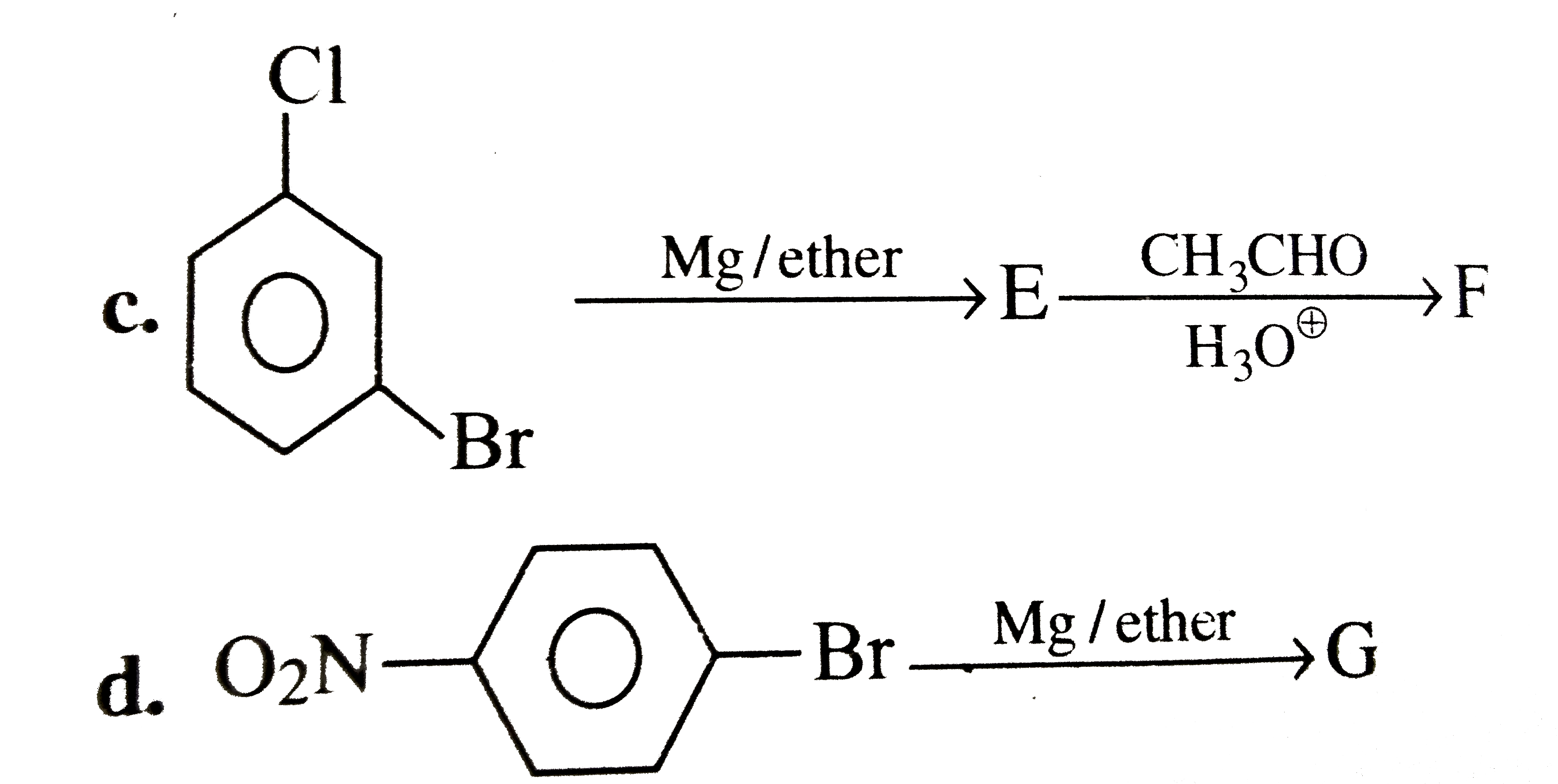Four isomeric optically active compounds NaHCO3−−−−−→CO2(g)(A,B,C,D)(C4H8O3)
Compound (A)LAH−−→(E) (Archiral compound)
Compound (B)KMnO4−−−−−→orCrO3 Inert to oxidation.
Compound (C)−−−−−−−−→NaOI/H3O⊕CHI3(Yellowppt.)+Compound(F).
Compound (D) is :
(I)
(II)
(III)
(IV)
The correct Answer is:C
To solve the problem, we need to identify the four isomeric optically active compounds (A, B, C, D) with the molecular formula C₄H₈O₃ and determine the structure of compound D based on the given reactions.
Step 1: Determine the Degree of Unsaturation (DU)
The formula for calculating the degree of unsaturation (DU) is:
DU=(2×number of carbons)+2−number of hydrogens2
For C₄H₈O₃:
- Number of carbons (C) = 4
- Number of hydrogens (H) = 8
Calculating DU:
DU=(2×4)+2−82=8+2−82=22=1
This indicates that there is one degree of unsaturation, suggesting the presence of one carbonyl group (C=O) or a double bond.
Step 2: Identify Possible Structures for Compounds A, B, C, and D
Given that we have four isomeric optically active compounds, we can propose the following structures:
1. Compound A: A possible structure could be a hydroxy acid, such as 2-hydroxybutanoic acid (CH₃-CH(OH)-CH₂-COOH).
2. Compound B: This compound is inert to oxidation, suggesting it could be a tertiary alcohol or an ether. A possible structure could be 2-methyl-2-butanol (CH₃-C(OH)(CH₃)-CH₂-CH₃).
3. Compound C: This compound reacts with NaOI/H₃O⁺ to yield CH₃I and another compound. A suitable structure could be 3-hydroxybutanoic acid (CH₃-CH(OH)-CH₂-COOH).
4. Compound D: This compound is formed from compound C and should be a product of the reaction with NaOI/H₃O⁺.
Step 3: Reaction of Compound C
When compound C (3-hydroxybutanoic acid) reacts with NaOI in the presence of H₃O⁺, it undergoes the iodoform reaction, producing CH₃I (iodoform) and another compound (which is likely to be a carboxylic acid).
Step 4: Identify Compound D
From the reaction, we can deduce that compound D is likely to be a carboxylic acid derived from the oxidation of compound C. Given the structure of compound C, compound D could be 3-oxobutanoic acid (CH₃-CO-CH₂-COOH).
Conclusion
Thus, the structure of compound D is 3-oxobutanoic acid (or acetoacetic acid).
The formula for calculating the degree of unsaturation (DU) is:
DU=(2×number of carbons)+2−number of hydrogens2
For C₄H₈O₃:
- Number of carbons (C) = 4
- Number of hydrogens (H) = 8
DU=(2×4)+2−82=8+2−82=22=1
This indicates that there is one degree of unsaturation, suggesting the presence of one carbonyl group (C=O) or a double bond.
Given that we have four isomeric optically active compounds, we can propose the following structures:
2. Compound B: This compound is inert to oxidation, suggesting it could be a tertiary alcohol or an ether. A possible structure could be 2-methyl-2-butanol (CH₃-C(OH)(CH₃)-CH₂-CH₃).
3. Compound C: This compound reacts with NaOI/H₃O⁺ to yield CH₃I and another compound. A suitable structure could be 3-hydroxybutanoic acid (CH₃-CH(OH)-CH₂-COOH).
4. Compound D: This compound is formed from compound C and should be a product of the reaction with NaOI/H₃O⁺.
When compound C (3-hydroxybutanoic acid) reacts with NaOI in the presence of H₃O⁺, it undergoes the iodoform reaction, producing CH₃I (iodoform) and another compound (which is likely to be a carboxylic acid).
From the reaction, we can deduce that compound D is likely to be a carboxylic acid derived from the oxidation of compound C. Given the structure of compound C, compound D could be 3-oxobutanoic acid (CH₃-CO-CH₂-COOH).
Thus, the structure of compound D is 3-oxobutanoic acid (or acetoacetic acid).
Topper's Solved these Questions
- CARBOXYLIC ACIDS AND THEIR DERIVATIVESBook:CENGAGE CHEMISTRY ENGLISHChapter:CARBOXYLIC ACIDS AND THEIR DERIVATIVESExercise:Exercises (Multiple Correct)
Explore 34 Videos
- CARBOXYLIC ACIDS AND THEIR DERIVATIVESBook:CENGAGE CHEMISTRY ENGLISHChapter:CARBOXYLIC ACIDS AND THEIR DERIVATIVESExercise:Exercises (Singlecorrect)
Explore 64 Videos
- CARBOXYLIC ACIDS AND THEIR DERIVATIVESBook:CENGAGE CHEMISTRY ENGLISHChapter:CARBOXYLIC ACIDS AND THEIR DERIVATIVESExercise:Exercises (Subjective)
Explore 19 Videos
- BIOMOLECULESBook:CENGAGE CHEMISTRY ENGLISHChapter:BIOMOLECULESExercise:Exercises Archives (Analytical And Descriptive)
Explore 8 Videos
- CHEMICAL KINETICSBook:CENGAGE CHEMISTRY ENGLISHChapter:CHEMICAL KINETICSExercise:Archives Subjective
Explore 23 Videos
Similar Questions
Knowledge Check
An optically active compound 'X' having molecular formula C4H8O3 . It evolves CO2 with NaHCO3. ' X 'on reaction with LiAlH4 give achiral compound. 'X' is:
A B
B C
C D
D
Compound (A)1molof−−−−−−→HIO4

The compound (A) is:
View SolutionCompound (A)(C6H8)[o]−−→ Malonic acid only. Identify compound (A).
View Solution (i)CH3CHO−−−−−−−→(ii)H3O+ (A) HBr−−→ (B)
(i)CH3CHO−−−−−−−→(ii)H3O+ (A) HBr−−→ (B)
The compounds (A) and (B)
View SolutionPhenyl isocyanide + Benzyl magnesium bromide 1.EtherΔ−−−−−→2.H3O⊕(A). The compound (A) is :
View SolutionXO3/Zn−−−→ ,

The IUPAC name of compound Y is :
View Solution(a)

(b)
( e) PhMgBrO2−−−→H3O⊕?
(f) Phenol+RMgI→?.
View SolutionC6H10NBS−−→(X)Mgether−−−−→(Y)CH3CN−−−−→H3O+(Z)
The compound (Z) is
View Solution